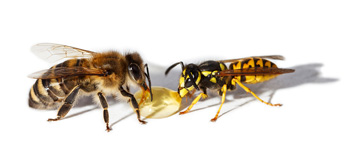Bee & Wasp Control and Hive Removals
Bees and wasps are beneficial to our environment, but they can be a real problem when they disrupt our favorite outdoor activities.Bet you don’t have a bee suit for getting rid of bees and wasps… But we do!
Well put our bee suit to good use if you’ve got a bee hive or wasp nest on your property. Don’t take chances with the safety of your family and pets!
Bees and wasps are beneficial insects (pollinators and predators of other insects), but they can also be very dangerous, especially if you have small children, or if someone in your family has a bee sting allergy.
Wasp and Bee Control
The first step in wasp or bee control is to correctly identify the insect and locate its nesting site. Our technicians are able to do just that.
CSI Exterminators wasp and bee control experts have been trained how to remove stinging insect hives and nests in the safest and most efficient manner possible. By correctly identifying the species, the best method of treatment can be applied.
If European honey bees are identified as the offending pest, our first step in control is to contact a local bee hive operator to determine if bees can be safely relocated or if the hive must be eradicated.
If eradication is necessary, we can take care of removing the bees and their hives.
If a hive is left inside of a wall, the honey from the hive will seep through and stain the drywall. It also acts as a “bait” for other unwanted pests.
Because CSI Exterminators holds a contractor’s license, we are able to perform the necessary construction activities required to remove and repair sections of wall.
If the pest is determined to be a wasp, our technicians will eradicate the wasps and remove their nests. If the nest is left intact, the wasps won’t return to them the following season, but other insects are drawn to them, especially carpet beetles.
Wasp Nests and Bee Hives
If they’re not nesting in manufactured hive boxes, European honey bees will often build their hives (made of wax) in the cavities of large trees, or inside the voids of building walls.
Wasps and hornets typically build their nests (made of a paper-like wood pulp and saliva) in quiet, out of the way places like the underside of roofing eaves, in attics and wall voids, on tree branches, or in abandon rodent burrows in the ground.
Nests that are near human activity can pose a potential problem. If there is a concern about stings, the nest should be eradicated.
Nests that are visible but are not near a home or other areas of human activity do not need to be treated. The most challenging nests to control are those that are concealed in voids behind walls or in attics. Often, the only evidence of the nest is bees or wasps flying back and forth through a crack or hole in the home.
Wasp and Bee Stings
Wasps and bees typically sting only to defend themselves or their colony.
When wasps or bees sting, they inject a protein venom that causes pain, itching, redness, swelling, and other reactions.
Bees can sting only once and they die shortly after; wasps however can sting multiple times, making them very dangerous. When a wasp or hornet stings, a pheromone is released signaling the rest of the hive to come and attack. Yellow Jacket wasps have been known to chase “intruders” for great distances while defending their nests.
The Africanized Honey Bee, or “killer bee”, is very dangerous, very aggressive, and attacks in large numbers. Africanized bees can be life-threatening to both people and animals who are unable to make a quick escape. Homeowners should NEVER try to take care of this type of bee problem on their own. If a bee hive is in a wall void, it is necessary to remove the hive from the wall once the bees are gone.

